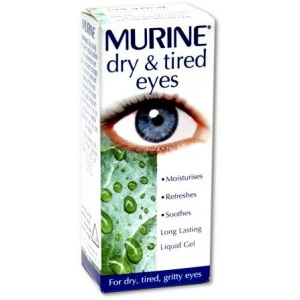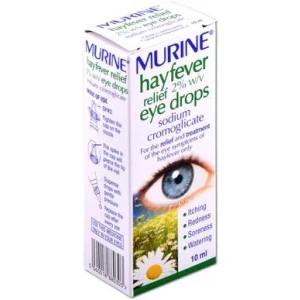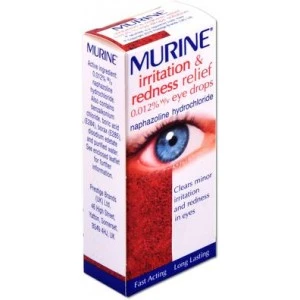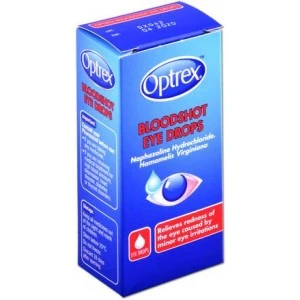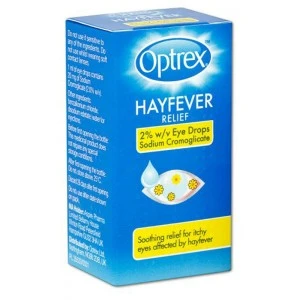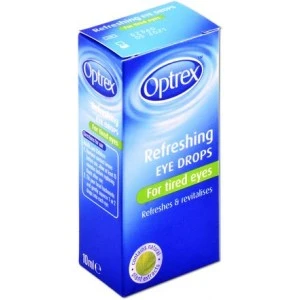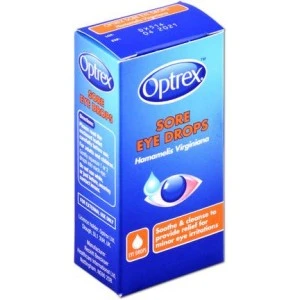Eye care
Your eyes are exposed to the elements, and while they have a protective layer of fluid, they are prone to infection and irritation from many cruxes of modern living.
Prescription Doctor offers a range of eye drops to bring relief from irritation, redness and other common eye ailments. See our products below.
Murine dry and tired eye drops
- Rehydrates eyes
- Lasts 8 hrs
- Easy to use
Murine Hayfever eye drops
- Relieves watering eyes
- Long-lasting
- Safe to use with contact lenses
Murine irritation and redness eye drops
- Relieves irritation
- Reduces redness
- Can be used with contact lenses
Optrex Bloodshot eye drops
- Reduces inflammation
- Relieves bloodshot appearance
- Available from a UK-registered pharmacy
Optrex Hayfever relief eye drops
- Relieves itchy eyes
- Reduces eye redness
- Available from a UK-registered pharmacy
Optrex Refreshing eye drops
- Replenishes tear film
- Rehydrates eyes
- Provides fast relief
Optrex sore eye drops
- Repairs tear film
- Relieves soreness
- Available from a UK-registered pharmacy
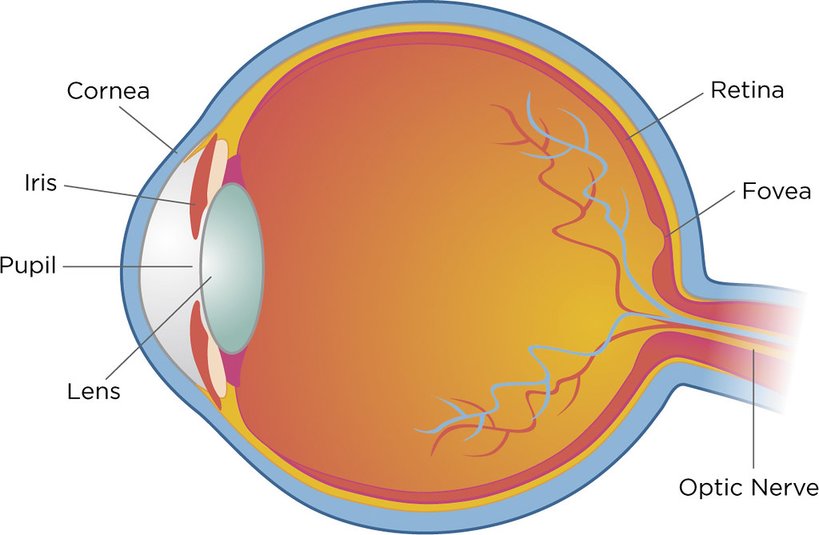 Our eyes are incredible organs which allow us to view the world around us. They can differentiate between more than 10 million individual colours and adjust to changes in light.
Our eyes are incredible organs which allow us to view the world around us. They can differentiate between more than 10 million individual colours and adjust to changes in light.
There are many aspects of modern life which take their toll on our eyes and can lead to dry, tired and irritated eyes. Staring at screens, spending long periods in dry, dusty, or polluted environments, and having hay fever can cause the fluid layer that protects the cornea to evaporate, leading to irritation.
The cornea is a clear layer that covers the pupil, iris, and lens of the eye and is responsible for refracting (bending) light that enters the eye. It is kept lubricated and cleaned by a veil of fluid called the tear film.
Tear glands (lacrimal glands), located at the top of the eyeball, produce a continuous flow of tear fluid. When we blink, the eyelids spread the fluid evenly across the eye's surface. The tear film evaporates every 15 to 30 seconds between blinks.
The tear film carried a range of functions, including:
- Lubricating the eyelids to allow them to move freely across the surface of the eye
- Supply the corneal cells with nutrients and oxygen
- Protect the cornea and conjunctiva from particles which could affect the eyes
- Helps destroy bacteria to protect from infections
- Cleans the eyes of foreign objects through the action of blinking
The tear film must be kept intact to protect the cornea from damage.
Eye drops can replenish the tear film and keep your eyes lubricated. Some eye drops can soothe discomfort and irritation, while other eye drop formulations can treat inflammation of the conjunctiva.
It's essential to select the appropriate eye drops for your specific condition. If you are unsure, speak to a doctor or pharmacist. Our online pharmacists can help you find the right eye treatment for your needs.
How do our eyes work?
The different colours of the visible light spectrum are divided into distinct frequencies, much like radio stations are allocated across different frequencies. Blue and ultraviolet (UV) light travel faster and have shorter wavelengths than red and infrared (IR) light, which have longer wavelengths. The shorter wavelengths carry more energy and penetrate further than longer wavelengths, which can often be easily blocked.
Your eyes process these variations in wavelengths, much like a camera, to perceive the different colours.
When light rays hit an object, they are either absorbed by the object we are looking at or reflected off the object and into our eyes. Whichever wavelengths are absorbed or reflected will determine the colour. The reflected light enters the front of the eye, called the cornea. The cornea bends the light and flips what we see.
Behind the cornea is the lens, which helps to focus on objects, and the iris. The iris is the coloured ring in your eye, which may be brown, blue, green or grey. The iris opens and closes to allow more or less light into the eye. In the dark, the iris opens, making the pupil (the name given to the hole in the middle of the iris) larger to receive more light.
At the back of your eyes is the retina. Here, there are 3 types of cone cells. Each of these cells is sensitive to a different colour of light: red, green, and blue. Due to the principles of additive colour, these three individual colours can be mixed to produce all other visible colours.
They capture the light to produce an image. The image captured on the retina will be upside down because the cornea bends the light. When the image is sent to the brain, it is flipped the right way up.
What are dry eyes?
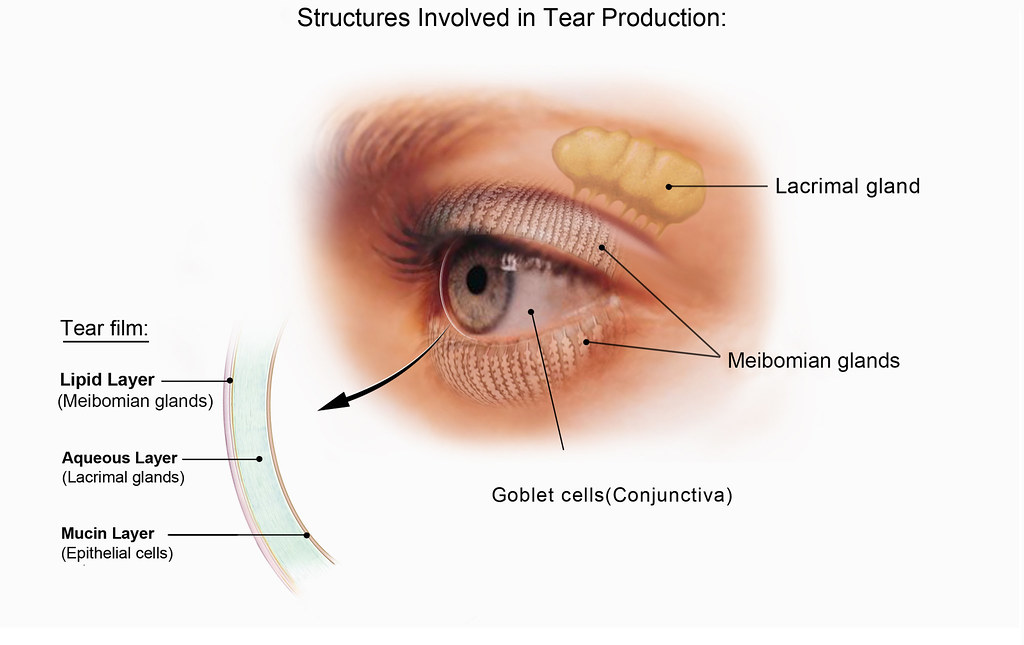 Dry eye syndrome (DES) can occur when the glands do not produce enough tears to keep the eyes adequately lubricated or when the layer of lubrication evaporates. In either case, dry eyes can be a frustrating and irritating nuisance.
Dry eye syndrome (DES) can occur when the glands do not produce enough tears to keep the eyes adequately lubricated or when the layer of lubrication evaporates. In either case, dry eyes can be a frustrating and irritating nuisance.
Dry eyes have recently been referred to as “screen eyes”, as the persistent use of screens in our daily lives can cause the protective layer of fluid over our eyes to evaporate faster.
Typical symptoms of dry eyes include:
- A gritty sensation in the eyes
- Blurred vision
- Irritation or soreness of the eyes
- Redness of the eyes (Bloodshot eyes)
- Sensitivity to light (photophobia)
- Watering eyes
The symptoms of dry eyes can be associated with other health conditions, such as allergies like Hay Fever. If you persistently suffer from dry eyes, you should speak to your doctor to rule out whether an underlying health condition causes your symptoms.
Age, hormones, medical conditions and even the environment we live in can cause dry eyes. This condition is more likely to develop if you:
- Are over the age of 50
- Have arthritis, blepharitis, diabetes, lupus or Sjögren's syndrome
- Spend prolonged time looking at computer screens without regular breaks
- Spend time in cold, dry, dusty or windy environments
- Wear contact lenses
While dry eye syndrome is typically diagnosed based on the symptoms alone, you should speak to your doctor or an ophthalmologist to determine whether there is an underlying cause to the condition.
Your doctor, pharmacist or ophthalmologist may also be able to suggest the best type of treatment for you, depending on your condition.
How can I treat dry eyes?
Dry and tired eyes usually resolve on their own while sleeping. However, if your symptoms are the result of medicine or an underlying condition, or if you experience dry eyes frequently, you may get effective relief from the use of eye drops.
Eye drops serve as an artificial replacement for the protective tear film that covers our eyes. They lubricate the eyelids and help maintain clear vision.
Eye drops intended for dry eyes may contain distilled witch hazel, which provides a soothing sensation when applied.
How can I prevent dry eyes?
If an underlying medical condition is causing your symptoms, you should speak to your doctor in order to treat the underlying condition directly.
Regardless of whether an underlying health condition causes your dry eyes or not, there are several ways you can prevent dry and tired eyes.
Stay hydrated by drinking plenty of water throughout the day to provide your body with the fluids it needs to regulate tears and maintain proper fluid balance in the eyes. If you are particularly prone to dry eyes, you should consider limiting or cutting out things which might cause or contribute to dehydration, such as drinking alcohol or smoking.
When using a computer, take regular breaks from looking at the screen and blink regularly to keep your eyes moist. You can also try the 20-20-20 method; for every 20 minutes spent staring at the screen, spend 20 seconds looking at something 20 feet or more away.
Adding moisture to the air can help combat dry eyes, and you don't need a dehumidifier to do so. Drying your clothes inside, cooking on a stove, taking a steamy bath or shower, and even simply leaving a bowl of water on a windowsill on a sunny day can increase the air's humidity.
When outdoors, protect your eyes from wind and the sun with wraparound sunglasses. Whenever possible, avoid dry and dusty environments or wear adequate eye protection.
Taking a break from wearing contact lenses can help to rest your eyes, as can getting an adequate amount of sleep.
What is conjunctivitis?
While dry eyes can be a nuisance on their own, various situations can cause eye irritation. Many of these conditions often co-occur with dry eyes, resulting in the appearance of red, bloodshot eyes.
Warm, dry and sunny days pose a significant threat to the lubricated layer of your eye. On top of the evaporation of moisture, particles of dust, sand and pollen can get into your eye and cause irritation and inflammation of the conjunctiva. This is called conjunctivitis.
There are 3 main types of conjunctivitis:
Infectious conjunctivitis
This condition is often caused by bacteria or a virus. It can be passed on to other people through contact with the eye or infectious discharge from the eye.
Allergic conjunctivitis
Often a symptom of hay fever, allergic conjunctivitis occurs when pollen comes into contact with the eye. The body releases histamine in response to the pollen, triggering the removal of the foreign substance. Histamine can cause inflammation of the conjunctiva. Allergic conjunctivitis is not contagious.
Irritant conjunctivitis
Irritants such as bleach, chlorine, and juices from foods like garlic, onions, and chilli peppers can irritate and sting the eyes if they come into contact with them. This can cause the eyes to appear red and bloodshot. Irritant conjunctivitis is not usually contagious.
Other names for conjunctivitis include "red eye" and "pink eye".
Typical symptoms of conjunctivitis include:
- Inflammation or widening of the blood vessels in the eyes (referred to as bloodshot)
- Mucous and/or watery discharge
- Redness of the eyelids
Other possible symptoms include:
- Burning or stinging sensation in your eyes
- Enlarged lymph node (gland) in front of the ear
- Gritty feeling in your eyes
- Sticky substance on your eyelashes
You should seek immediate medical advice if you notice any of the following symptoms:
- Disturbances in vision
- Eye pain
- Sensitivity to light (photophobia)
- Severe redness in the eye(s)
How to treat conjunctivitis?
Infective conjunctivitis, caused by a bacterial or viral infection, is contagious and can be easily passed on to other people. If you notice pus or a sticky substance being secreted from your eyes, consult your doctor. Should your conjunctivitis be caused by bacteria, they will prescribe a course of antibiotics to combat the condition. Antibiotics will not be effective if a virus causes your condition.
If you suspect you have infectious conjunctivitis, speak to your doctor.
Allergic conjunctivitis can be treated with antihistamines (such as fexofenadine or cetirizine) and other allergy treatments, such as hay fever eye drops. These can be available over-the-counter or on a prescription from your doctor.
Irritant conjunctivitis usually doesn't require medicated treatment and typically clears up shortly after the irritant is removed from the eyes. In most cases, rinsing your eyes with clean water is sufficient to wash away the substance. However, if the irritant was bleach (such as hydrogen peroxide), acid or another damaging substance, you should seek emergency medical attention as exposure to such corrosive chemicals can result in blindness.
In any case, you should take appropriate precautions to prevent the spread of conjunctivitis to other people, even if your condition isn't contagious.
Avoid rubbing your eyes. If your conjunctivitis is caused by an abrasive particle, such as sand, you could run the risk of scratching your cornea. Moreover, the offending particle may become lodged between the eyeball and eyelid, causing further irritation or infection. You should rinse your eyes with cold water as soon as you can after they come into contact with an irritant.
Wash your hands regularly with antibacterial soap to prevent bacteria from entering the eye and causing further irritation. You should also wash your pillow and any surfaces which might have come into contact with your eyes and the surrounding areas. If you wear contact lenses, consider switching to glasses until your infection has cleared up.
How do I put in eye drops?
Here's how to put in eye drops.
If you wear contacts, remove them before putting in your eye drops.
- Tilt your head back and look up at the ceiling.
- Pull your lower eyelid down.
- Without touching your eye with the dropper, apply the required number of drops to the eye.
- While keeping your head tilted back, close your eyes for several seconds.
- Open your eyes and wipe away any residual fluid which may run down your face.
- Repeat steps for the other eye if necessary.
Wait 15 minutes after applying eye drops before reinserting your contacts.
Buy eye drops online from Prescription Doctor
Prescription Doctor offers a range of eye drops for various conditions. Whether you are suffering from dry, tired eyes due to long work hours or eye strain, allergic conjunctivitis as a result of hay fever, or bloodshot eyes caused by an irritant such as chlorine, we have a suitable treatment for you.
Eye drops for dry eyes can be purchased over the counter at your local pharmacy or online from trusted sources, such as Prescription Doctor.
There is a range of products which can be used depending on the severity of your condition, including:
- Optrex
- Murine
Your symptoms and their severity should be taken into account when selecting the most suitable treatment for you. Moreover, if you wear contact lenses, you will need to read the directions on how to use eye drops with contact lenses, as some eye drops can damage contact lenses and impede your vision.
Both Optrex and Murine offer products for dry eyes, irritated or red eyes, and allergic conjunctivitis, which you can buy online using Prescription Doctor's online pharmacy service.
If you are unsure which products are suitable for you, speak to your pharmacist for advice.
All products bought from our online pharmacy are dispatched in discreet packaging to ensure your privacy. We offer next-day delivery to ensure your treatment arrives promptly.
Authored & Reviewed By

Mohamed Imran Lakhi
MPharm - Lead PharmacistPublished on: 13/02/2020 Reviewed on: 18/05/2023
© 2013 - 2026 Al Muhsineen Limited. All Rights Reserved. Registered Pharmacy: 34 Halliwell Road, Bolton BL1 8RL. Registered Office: 254 First Floor, Shearbrow, Blackburn, England, BB1 8DS

